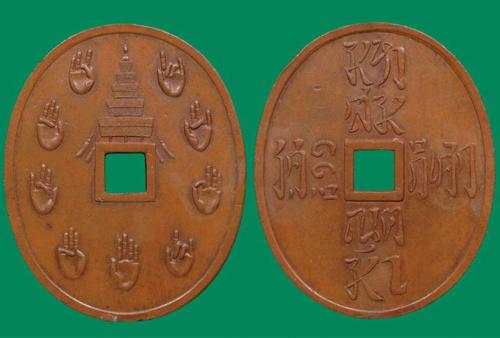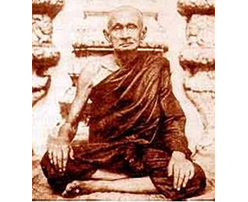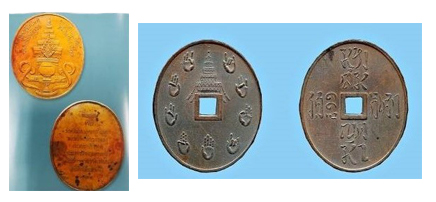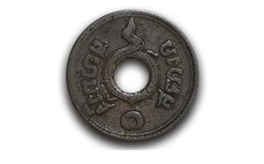Maha Samanuttama Phisek Medals (Rian Mue or Palm Medal) Chinese-style Medals during the Reign of King Rama V
Somsak Ritpakdee*
King Rama V of Thailand commissioned creations of medals on many occasions during his reign. Like usual medal designs, most medals are flat and round. Those which are important and well-known are, for example, Phra Chulamongkhut medals, Sataphatmala medals, medals on the occasion that the king had reigned as long as King Rama I. The medals were created to memorialise important events related to Kings, the members of the royal family, or important individuals. They carry images or symbols representing the events, along with mottos, and the year in which the event took place. They are a record of historical events, and are considered primary historical evidence just like inscriptions and chronicles, thereby bearing equal historical value. During the reign of King Rama V, many medals were commissioned for this purpose. Discussed here is a model whose design interestingly carries a hidden meaning in the form of a Buddhist riddle. It is commonly called ‘Rian Mue’, translated as palm medal, or ‘Maha Samanuttama Phisek 2nd Style’. It is commissioned to commemorate the occasion that the 8th Supreme Patriarch of Rattanakosin took office, and is one of the important medals created in this period.
History and significance of the royal Maha Samanuttama Phisek ceremony
The term ‘Maha Samanuttama Phisek’ appeared for the first time in the Rattanakosin period when King Mongkut or King Rama IV promoted Prince Nuchitchinorot from the rank Kromma Meun to Krom Somdet Paramanuchitchinorot. (Nowadays the title Krom Somdet is Krom Phraya.) The prince became the supreme authority over the Sangha across the entire kingdom. On this occasion, the king ordered that a ceremony called ‘the royal Maha Samanuttama Phisek ceremony’ be held for the first time at Wat Phra Chetuphon Wimol Manklaram in 1851. The ceremony was similar to the king’s coronation ceremony; both Buddhist and Brahmin rites were conducted. It was the first coronation ceremony held for the head of the Thai Sangha who was also the first high-ranking royal family member to have entered monkhood and become the Supreme Patriarch of Thailand.
During the reign of King Rama V, the king opined that, holding the royal title Phra Chao Borommawongther, Prince Pawaret Wariyalongkorn had higher a rank than common monks. The Prince was also the longest living royals in the Chakri Dynasty. He was well respected by other royal family members, as well as the people. Plus, he was the preceptor to the Crown Prince Maha Wachirunnahit when the Crown Prince was a novice. Therefore, the king granted Maha Samanuttama Phisek ceremony to Phrachao Borommawongther Prince Pawaret Wariyalongkorn, thereby elevated his royal title to Somdet Phra Maha Samanachao Krom Phra Pawaret Wariyalongkorn. Consequently the prince held the authority over the Sangha both in Bangkok area, an all cities on the kingdom as ‘the 8th Supreme Patriarch of Rattanakosin’. The ceremony took place at Wat Bowonniwet Vihara on 27th November 1891.
In sum, the royal Maha Samanuttama Phisek ceremony refers to the coronation ceremony of the Supreme Patriarch of Thailand in the case that the monk receiving office is a member of the royal family or a high-ranking noble. When Prince Pawaret Wariyalongkorn was crown the Supreme Patriarch, the royal Maha Samanuttama Phisek ceremony was held. King Rama V commissioned a creation of medals as a gift for royal family members, high-ranking officials, and members of the clergy. On one side of the medals, there is a text ‘Maha Samanuttama Phisek’ written in the style that was popular during King Rama V’s period. There were two models: the first is called ‘Rian Bart Nammon’ or ‘blessed water bowl medal’; the second is called ‘Rian Mue’ or ‘palm medal’
Somdet Phra Maha Samanachao Krom Phra Pawaret Wariyalongkorn
Source: http://th.wikipedia.org
(Left) The Maha Samanuttama Phisek medal design 1 or Rian Bart Nammon
Source: Chatchawan Woowanich. Coins produced in the reign of King Rama V, Bangkok
(Right) The Maha Samanuttama Phisek medal design 2 or Rian Mue
Source: www.banpra-lakroy.๙๙wat.com
The importance of the Maha Samanuttama Phisek medal design 2 or Rian Mue
It is one of the two models that were created as a memento for the royal Maha Samanuttama Phisek ceremony held in 110 Rattanakosin Era (1891). Thus, the medals were named after the ceremony— Maha Samanuttama Phisek Medals. They are also commonly called ‘palm medals’ or ‘Hatha Mudra medal’ due to the images on the medals. The medals were given as a gift for royal family members, high-ranking court officials, monks, and civil servants who were involved in the ceremony. Moreover, they were given as a prize for the winners and a token for the judges in the alter-setting table competition held during the celebration of a new clerical rank of Prince Pawaret Wariyalongkorn at Wat Bowonniwet Vihara too. This was the first time a medal were created in the event relating to Thai Sangha.
Features and designs of the palm medal
The Maha Samanuttama Phisek medal design 2 are similar to Chinese coins. They were made of bronze metal, oval-shaped, 44 mm in width and 55 mm in length. There is a hole in the centre of the medal, which is a distinct character of Chinese coins. Such style might have been done to permit their being strung on cords so that they could be carried in large numbers. The earliest evidence of this kind was coins from Qin Dynasty dating back to 2nd-3rd Buddhist Century. Additionally, some palm medals were found to have a metal hoop attached to the top and the bottom so that the medal can be connected with a tuft using a string, then hung from a stick which is placed in a vase as a part of Chinese-styled altar table set. This particular feature of the medal could be an indication that Chinese-style altar table setting was in fashion back then. It can be said that the creation of medals according to Chinese art during King Rama V’s period was a result of the Chinese influence over Thai courtly customs which had been present since early Rattanakosin period. Moreover, other types of medals created during King Rama V’s reign might have also been under such Chinese influence as they resembled Chinese medals. For example, the medals in circulation then were called ‘Satang Ru’ which means a medal with a hole.
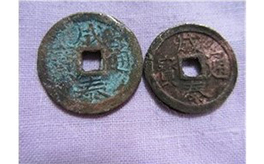
Chinese coins with a hole in the center
A palm medal haning from a stick which is placed in a vase
Source: Rungsilp Printing
A circulation coin during the reign of King Rama V
Source: The Bureau of Grand National Treasure under the Treasury Department
On the obverse of Maha Samanuttama Phisek medal, there are images of palms, including four images of a right palm on the left side, four images of a left palm on the right side, and another one at the bottom. Each is of a different gesture, in other words, different mudras according to Chinese art. The image at the bottom is of a fully opened left palm. There are nine images of palms in total. Above the hole in the centre, there is an image of a five-tiered umbrella, with double layer ornamental fringe. There is a decorative band along the rim of the medal.
The obverse of a palm medal
Source: The Bureau of Grand National Treasure under the Treasury Department
The reverse of a palm medal
Source: The Bureau of Grand National Treasure under the Treasury Department
On the reverse of the medals, there are Thai letters designed in Chinese style across the medal in four directions. They can be read ‘Maha Samanuttama’ from top to bottom, and ‘Phisek 110 Rattanakosin Era’ from left to right. Like on the obverse, there is a decorative band along the rim of the medal.
The meanings of the images and symbols on the palm medal
The obverse of the medal carries several images. Over the square hole in the centre, there is an image of a five-tiered umbrella with a double-layered fringe decorated with two tufts on both sides of the umbrellas. The shaft of the umbrella is visible in the centre. There are nine images of palms performing different mudra gestures , and forming a circle. They are icons of the Lord Buddha or Bodhisattvas as can be seen in Chinese art. Scholars have different assumptions and interpretations regarding the images of the palms, which can be summarised as follows:
Firstly, the images might have referred to calculations in astrology, or to convey a meaning that rhymes with the name of the Prince Supreme Patriarch, i.e. ‘Ruek’ which means ‘an auspicious moment’. The prince biography also shows that he was well-versed in the occults and astrology, and regularly gave King Rama V consultations in this regard.
Secondly, the images might have been a symbol of auspicious incantation, or nine auspices according to Buddhist belief, namely luck, prestige, power, glory, longevity, status, blissfulness, might, and wealth.
Thirdly, the images might have been a Buddhist riddle, representing the teaching of the Noble Eightfold Path. According to Chao Khun Phra Siwisutdilok of Wat Prayoon Wongsawat (Reng who has graduated in highest level in Buddhist theology), each image of palm can be interpreted as follows:
On the left side of the medal are images of a right palm. Below is the interpretation of each image from top to bottom.
1. Showing the middle finger means keeping the mean, or keeping a proper position. This is called ‘Samma Ditthi’ or right view.
2. Showing the little finger represents proper verbal usage. It is called ‘Samma Vaca’ or right speech.
3. Showing the ring finger represents correct professions. It is called ‘Samma Ajiva’ or right livelihood.
4. Little finger touching the thumb represents a good state of awareness, namely being aware of the past, the present, and the future. This is called ‘Samma Sati’ or right mindfulness.
On the right side of the medal are images of a left palm. Below is the interpretation of each image from top to bottom.
1. Showing the middle finger and the ring finger means commencing, with both good and bad intentions. This is called ‘Samma Sankappa’ or right intention.
2. Showing the ring finger means doing work properly. This is called ‘Samma Kammanta’ or right action.
3. Showing the index finger and the thumb represents work efforts. This is called ‘Samma Wayama’ or right effort.
4. Showing the middle finger and the ring finger means concentration which necessitates determination and good health. This is called ‘Samma Samadhi’ or right concentration.
The fully open left palm at the bottom of the medal means a complete state of being a person; the sum of the Noble Eightfold Path which concerns both the worldly and otherworldly realm. All the images on the medal were meant to be a Buddhist riddle that suggests this very doctrine of the Eight Noble Paths.
Fourthly, the images might have meant to convey different teachings in Buddhism. This interpretation is possible because the Supreme Patriarch was well-verse in Pali and Buddhist doctrine. The images of nine palms performing different gestures might have been riddles which remain unsolved.
Finally, from the perspective of art, the images of palms performing different gestures might have been the mudra gestures commonly found on Buddha figures created in Chinese style, according to Chinese Mahayana Buddhism. They often carry a deep religious message. For this reason, these medals are also called ‘Rian Hatha Mudra’ or ‘Mudra medals’. The resemblance between the image of different palm gestures and the mudras in Chinese art suggests a Chinese influence. The features of the medals which are similar to ancient Chinese coins also indicate the same influence.
The designs on the reverse of the medal include several embossments of Thai words created especially to look like chinese characters. They appear across the medal in four directions. From top to bottom, it reads ‘Maha Samanuttama’; from left to right it reads ‘110 Rattanakosin Era Phisek’. The medals were made of bronze, measured 44 mm in width, 55 mm in length. They were created in 1891 (110 Rattanakosin Era).
In conclusion, Maha Samanuttama Phisek medals were the first medals that were created on the occasion related to the Supreme Patriarch or a Buddhist monk. They were a token for this important ceremony to celebrate the elevation of the rank of a royal family member. Containing religious riddles, they carry deep and complex meanings, which might have had a personal meaning to the person they were intended to memorialise. The purpose of the medals was to be given to royals, officials, and monks who held high ranks. They are especially important and invaluable because they memorialised the important event of the time and the persons involved. Moreover, the designs and the use of the medals, i.e. for altar table setting, clearly indicate the cultural influence China had over Thai court during King Rama V’s period. Apart from having similar physical features to Chinese coins, the images and writings on the medals were also created to imitate Chinese character. In this vain, Mahanuttama Phisek medals or Rian Mue are a good example that medals can indeed reflect important events, culture and the beliefs of the past which will certainly be of benefit to future generations.
* Curator, Professional Level at Bureau of Grand National Treasure under the Treasury Department
